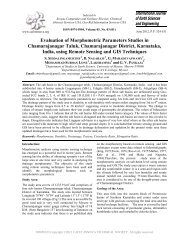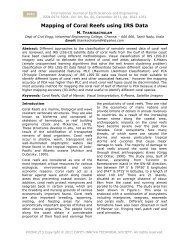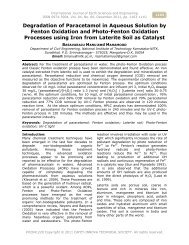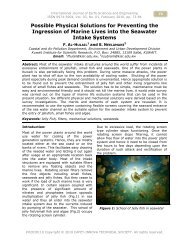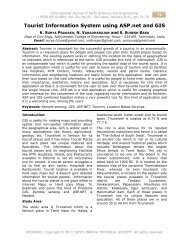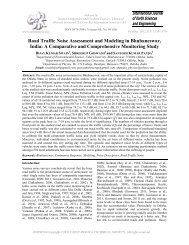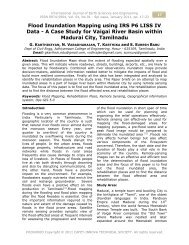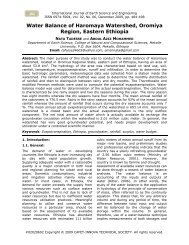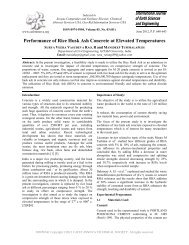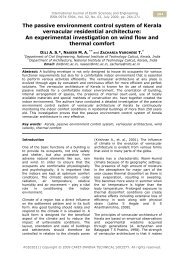02050552 - Cafet Innova
02050552 - Cafet Innova
02050552 - Cafet Innova
Create successful ePaper yourself
Turn your PDF publications into a flip-book with our unique Google optimized e-Paper software.
1467 P. V. S. VARA PRASAD and S S. ASADI<br />
toposheets of Survey of India in 1:50,000 scale and<br />
updated using latest satellite data wherever deviations<br />
and new developments are observed. Step I: All the<br />
rivers its tributaries and drainage network shown on the<br />
toposheets are captured. The boundaries of all<br />
rivers/water bodies with names appearing are captured<br />
from toposheets. The drainage is drawn from whole to<br />
part, i.e., from the rivers to tributaries to first drains to<br />
second order drains to third order drains. Step II: Based<br />
on the post monsoon satellite image extent of water<br />
spread and dry parts are updated. The water bodies<br />
which did not exist at the time of survey of toposheets,<br />
if any are also captured based on satellite imagery.The<br />
study area forms lower part of Pennar basin and the<br />
river Pennar flows through the middle of the area from<br />
western part, towards East. All these rivers and rivulets<br />
get dry for major part of the year and carry heavy floods<br />
during rainy season. The Pennar river is most<br />
important river, a boon to the eastern half of the taluks<br />
of Nellore and Kovvur. It flows for about 112 kms in<br />
the area through Atmakur and between Kovvur and<br />
Nellore and falls into the Bay of Bengal.The Penner<br />
river confluence with Cheyyeru three km before<br />
Somasila gorge and is traversed and enters the Nellore<br />
district. The Somasila anicuts is at this point the border<br />
of Nellore and Kudapa Dist. Flows slightly towards<br />
north east up to Sangam Anicut, The River turns in a<br />
south-easterly direction towards Nellore Anicut. A few<br />
kilometers below Nellore town, the course takes a sharp<br />
turn to the north-east and falls into the Bay of Bengal<br />
Sea at Utukur estuarine region. The Pennar Delta is<br />
having a four major, fourteen medium and forty-one<br />
minor drains. The main drain basins are Maldevi, the<br />
Alluri swamp, Nakklavagu and Paideru vagu. The<br />
Paideru traversing for distance of 43.2 Km joins the Sea<br />
at Ponnapudi village at Vidavaluru mandal. The rest<br />
three drains, River Pennar, Chippaleru and Uppateru,<br />
which finally empties into sea.The Penner and its<br />
tributaries are practically dry before the on set of SW<br />
monsoon and they begin to flow after the rains. The<br />
maximum flow in the river will be during the months of<br />
August, September and October. After December, the<br />
rivers are practically dry. It has two old anicuts<br />
constructed by British one at Sangam and the other at<br />
Nellore and a Major Irrigation project the Somasila<br />
constructed recently.<br />
4.3 Watershed Map:<br />
Watersheds are hydrological units that are considered to<br />
be efficient and appropriate for assessment of available<br />
resources and subsequent planning and implementation<br />
of various development programmes. The watershed<br />
map is prepared in accordance with the National<br />
Watershed Atlas (1990). India is divided into 6 regions<br />
out of which the present study area comes under<br />
Region-4 i.e. the river flowing into Bay of Bengal. The<br />
total area occupied by this region is 1130.48 lakh.<br />
Present study area falls under basin-C i.e. between<br />
Cauvery and Krishna basin which has a total area of<br />
14,606 hectares. The total catchment is divided as 3 and<br />
4 which includes Pennar (5740 ha) and Pennar Krishna<br />
(2426 ha). The 3 catchment is further divided into A, B,<br />
C, D etc sub-catchments. The sub-catchment-A i.e.<br />
Lower Pennar 536 ha consists of the present study area<br />
and occupies the 1(Right Bank Pennar) and 2 (Left<br />
Bank Pennar) watersheds. The 4 catchment is further<br />
divided into A, B, C, and D etc sub-catchments. The<br />
sub-catchment-A i.e. Maneru 479 ha consists of the<br />
present study area and occupies the 1(Bungale) and<br />
2(Upputeru) watersheds. For a detailed study the<br />
4C3A1, 4C3A2 and 4C4A1 watersheds are further<br />
divided into sub-watersheds (4C3A1a etc.), miniwatersheds<br />
(4C3A1a1 etc.) and micro-watersheds<br />
(4C3A1a1a etc.).<br />
Table: Land Use / Land Cover Classification<br />
Landuse / Landcover<br />
Double Crop 12305<br />
Single Crop 8615<br />
Aquaculture 10812<br />
Dry river 1921<br />
Scrub forest 831<br />
Land with Scrub 910<br />
Fallow lands 11<br />
Plantations 750<br />
Scrub forest 784<br />
Marshy/Swamp lands 220<br />
Saltpans 131<br />
Settlements 726<br />
Dry tank /River 1343<br />
River/tank with water 1546<br />
Sand area 775<br />
Water logged area 25<br />
4.4 Land Use / Land Cover Map:<br />
Area In Ha<br />
The LU/LC map (Fig.) of the study area is prepared<br />
from satellite imagery using visual interpretation<br />
technique. This technique consists of a set of image<br />
elements, which help in the recognition or interpretation<br />
of various land use /land cover features systematically<br />
on the enhanced satellite imagery during the<br />
classification of features (Lillesand and Kiefer 1994).<br />
A preliminary image classification key is prepared for<br />
the fused pictorial data and is used during interpretation<br />
process. The base map is overlaid on the satellite<br />
imagery. Then the features of LU/LC classes are<br />
International Journal of Earth Sciences and Engineering<br />
ISSN 0974-5904, Vol. 05, No. 05 (02), October 2012, pp. 1464-1471



